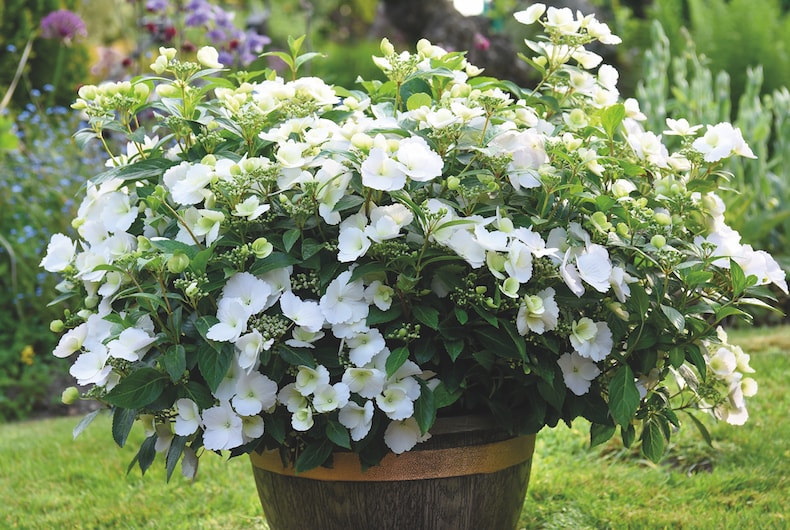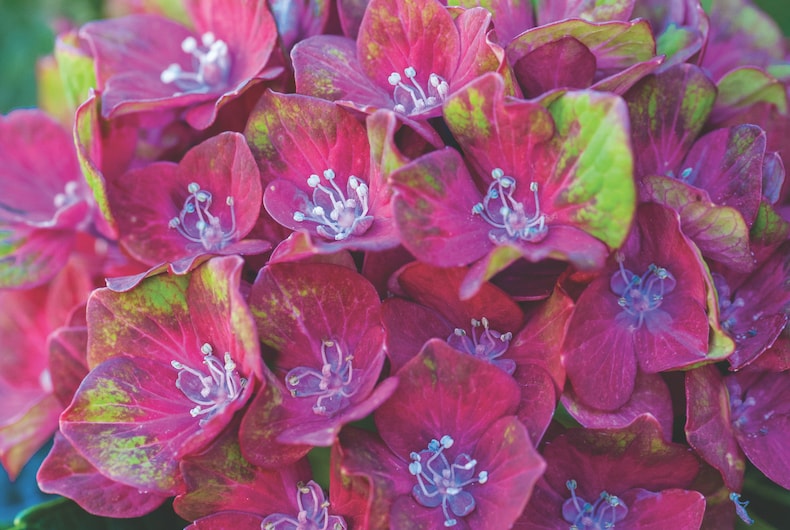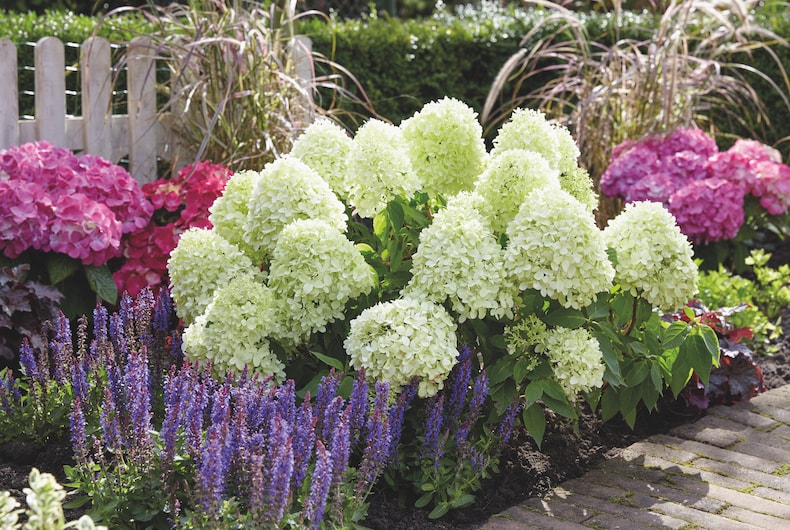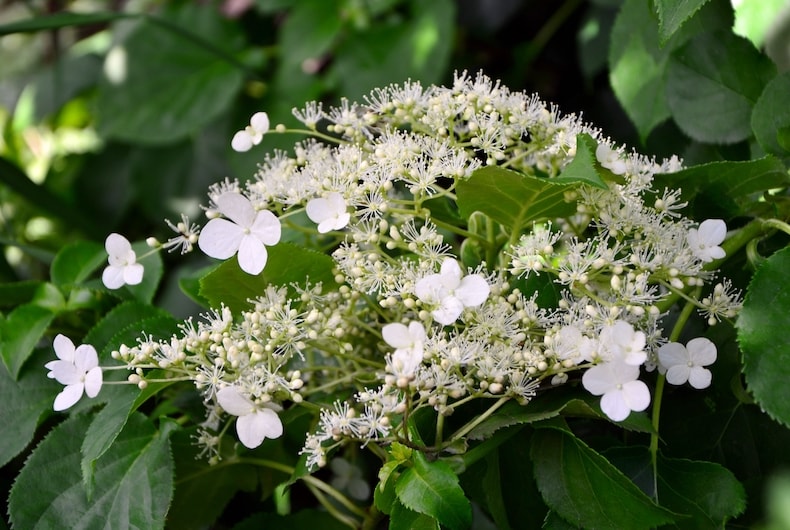
How to prune a hydrangea
To keep your hydrangea flowering at its best, you need to prune annually. At the same time, you should remove a few of the oldest stems each year to encourage new growth and rejuvenate the entire shrub. Hydrangea macrophylla varieties are pruned differently to H. paniculata, H. arborescens and climbing hydrangeas. Here, expert horticulturalist Mandy Bradshaw explains how and when to prune each type.
Browse our full range of hydrangea shrubs for inspiration.
How do I know what type of hydrangea I have?

This award-winning lacecap produces huge numbers of flowers on each stem
Image: Hydrangea 'Runaway Bride' from Thompson & Morgan
When it comes to pruning, the two main varieties of hydrangea are: those that produce blooms on the previous year’s growth (old wood); and those that produce flowers on new growth. Both types are best pruned in February-March, but the method is different for each.
Whichever type of hydrangea you have, regular pruning helps to maintain a good shape and rejuvenates the plant by encouraging plenty of new growth. And it’s this strong, new growth that ensures you have lots of large, healthy flowers to enjoy in the years to come.
Pruning hydrangeas that flower on the previous year's wood

Hydrangeas that flower on old wood can simply be deadheaded each spring
Image: Hydrangea macrophylla Glam Rock 'Horwack' from Thompson & Morgan
Hydrangea macrophylla cultivars, including the most popular mophead and lace-cap varieties, produce flowers on last year’s old wood. You can deadhead these (especially the hardy lacecap varieties) after they’ve flowered in the summer by cutting the stems back to the next pair of strong, healthy buds. However, it’s best to leave the faded blooms in place over the winter to protect tender new buds from frost damage. Most gardeners choose not to remove flower heads until spring, just to be sure.
For established plants, it’s good practice to remove any crossing, dead or weak stems, and to cut one or two of the oldest stems right back to the base each spring. These will then be replaced by strong new growth, continually rejuvenating the shrub over time.
Wondering how to tackle a neglected hydrangea? Most shrubs will tolerate a hard prune back to a low framework of stems in the spring, but doing this will mean that you won’t get any flowers that summer.
Pruning hydrangeas that flower on new growth

Hydrangeas that flower on new growth can be pruned hard in spring and still flower that year
Image: Hydrangea paniculata 'Little Spooky' from Thompson & Morgan
H.paniculata and H. arborescens flower on shoots made in the current season of growth. It’s best to prune these shrubs in February-March so that there’s plenty of time for the plant to grow strong, new, upright stems on which the large flowers will appear later that summer.
You can prune all of the old branches of these shrubs back to the lowest pair of healthy buds near ground level, creating a neat framework. If your shrub has been allowed to grow a main trunk for extra height, simply prune the old stems back to it.
If you don’t prune these hydrangeas, you’ll notice that your shrub begins to look like a tangled mass of stems and the flowers get progressively smaller each year.
Pruning climbing hydrangeas

Climbing hydrangeas should be pruned in summer, when they've finished flowering
Image: Hydrangea petiolaris from Thompson & Morgan
While most hydrangeas are pruned in early spring, climbing hydrangeas are the exception and should be pruned immediately after flowering in summer. Simply remove the faded flower heads, cut back any dead or straggly stems, and shorten any wayward shoots to contain them in their space.
If you need to give your climber a light trim earlier in the year, prune the top as lightly as possible. Most of the new flowers will appear towards the top of the plant and you don’t want to lose them. If you need to reduce the size of an established climbing hydrangea more dramatically, try to do it over the course of several summers so that flowering is not affected too much.
You should now have all the information you need to keep your hydrangeas in excellent shape and covered in bloom. Head over to our hub page and find all our hydrangea resources and growing guides in one place.
See all pruning guides
Individual guides
Flower & Shrubs
- Pruning Buddleja
- Pruning Camellias
- Pruning Clematis
- Pruning Fuchsias
- Pruning Hypercium - St Johns Wort
- Pruning Lavender
- Pruning Magnolias
- Pruning Passion Flowers
- Pruning Rhododendron
- Pruning Ribes Sanguineum
- Pruning Rosemary
- Pruning Roses
- Pruning Tree Peonies
- Pruning Wisteria
- Pruning Asparagus
- Pruning Blueberries
- Pruning Goji Berries
- Pruning Honeyberries
- Pruning Raspberries
- Pruning Apple trees
- Pruning Box and Yew trees
- Pruning Catalpa trees
- Pruning Christmas trees
- Pruning Olive trees
- Pruning Patio Fruit trees
- Pruning Pear trees
- Pruning Plum trees
Fruit & Veg
Trees

Written by: Mandy Bradshaw, the Chatty Gardener
Cotswold-based Garden Media Guild member, Mandy Bradshaw, is also known as the Chatty Gardener. Passionate about gardening and writing, her beginnings are in football reporting for her primary school, and Mesembryanthemum planting with her mother. Winner of the 2018 Property Press Awards 'Garden Journalist of the Year', she writes for not only her own blog but also a range of newspapers, magazines and other gardening and non-gardening sites.Banner image: Marina Andrejchenko/ Shutterstock
Sign Up For Exclusive Special Offers




© 2025 Thompson & Morgan. All rights reserved. A division of Branded Garden Products Limited.



